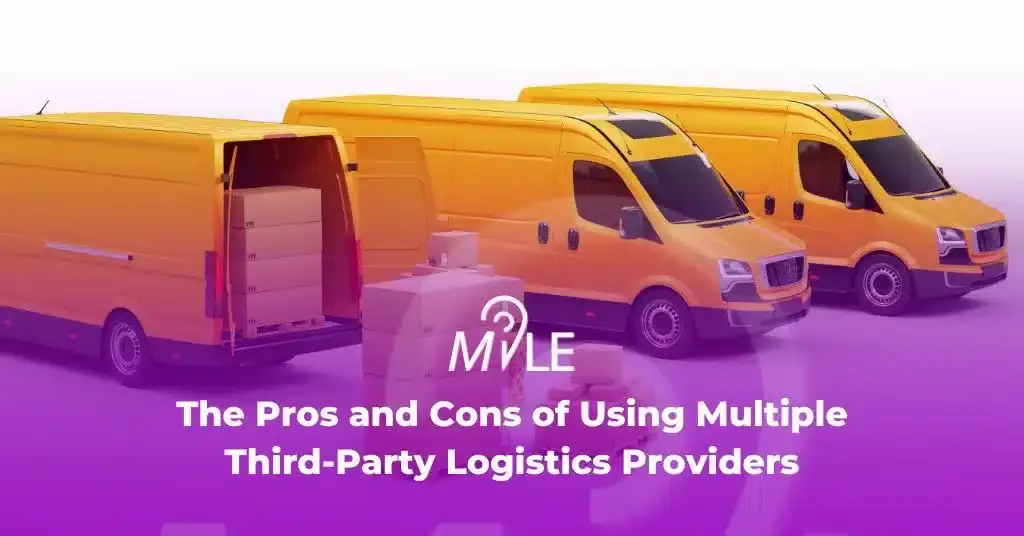The Pros and Cons of Using Multiple Third-Party Logistics Providers

As businesses scale their offerings and venture into new markets, ensuring timely and accurate deliveries to a growing number of customers becomes increasingly challenging. For e-commerce platforms in particular, efficiently managing fulfillment operations is critical for long-term success. However, as order volumes increase and product offerings diversify, internal logistics can become a significant bottleneck.
Not to mention customer satisfaction, which in today’s competitive environment, hinges not just on product quality and price, but also on exceptional delivery experiences. It’s little wonder that many companies are now turning to third-party logistics providers (3PLs) to meet these heightened customer expectations. And why not?
With their specialized expertise in shipping and fulfillment, 3PLs offer a powerful solution to streamline operations and prioritize customer satisfaction, allowing ecommerce businesses and aggregators to focus on core competencies and drive brand loyalty.
While some companies outsource their delivery operations to one 3PL provider, others choose to work with multiple 3PLs to improve their overall supply chain management. But the latter approach is not without its pros and cons. If you want to know what they are and how to choose the right one for your e-commerce business, this post is for you.
But first things first…
What Third-Party Logistics Providers Do
Third-party logistics providers offer various services to support a business’s shipping operations. They handle everything from moving goods between manufacturers and distributors to delivering them to the end-customer. Businesses often use these 3PL services to outsource their shipping and fulfillment tasks, which can include:
- Moving and storing goods
- Purchasing of materials
- Managing stock levels
- Processing import and export documentation
- Conducting freight audit
- Handling payments
- Tracking shipments
3 Pros of Using Multiple Third-Party Logistics Providers
Despite the fact that many businesses have found success with outsourcing logistics to a single 3PL, an increasing number are realizing the advantages of multiplying their partnerships and working with more than one provider.
Risk Mitigation
Having multiple 3PL partners allows businesses to diversify their supply chain and lessen the impact of any one supplier’s failure. Just in case one of your 3PLs has problems or fails to meet its service-level agreement (SLA), other providers can always step in and keep operations running smoothly. This method of reducing risk is especially important in sectors where delivery times are critical or where supply chain interruptions can have far-reaching effects.
Speedy Delivery
E-commerce has changed the game when it comes to delivery speed. Remember the good old days when two-day shipping felt like teleporting? Thanks in part to e-commerce giants like Amazon, now everyone wants it yesterday. Driven by consumer thirst for rapid deliveries, transportation strategies prioritize speed above all else. With multiple 3PLs at your disposal, you can leverage express shipping, same-day deliveries, and even drones logistics to get products to doorsteps faster.
Increased Scalability
When you outsource your logistics to different 3PLs, it helps you handle changes and grow your supply chain smoothly. Each 3PL you onboard might be better at certain order fulfillment tasks than others or specializes in a particular service or area. For instance, if you operate in a heavily regulated industry or have specific requirements, such as cold storage or temperature-controlled distribution, opting for a conventional 3PL might not be the ideal choice. Moreover, considering that third-party logistics providers often serve numerous clients, ranging in the hundreds or even thousands, you might not receive the personalized attention necessary for your unique demands.
That’s when having a network of diverse 3PL partners becomes exceptionally handy — you can effortlessly adapt to changing market demands by increasing or decreasing capacity, switching providers, or scaling up or down operations. This flexibility, in turn, helps you save money, deliver things faster, and meet the changing needs of your customers better.
3 Cons of Using Multiple Third-Party Logistics Providers
The use of several 3PLs concurrently brings with it a host of downsides for many aggregators. Things could become messy fast if you can’t manage the order volume despite having multiple logistics partners on board.
Increased Operational Complexity
In the online shopping world, real-time tracking of orders is super important to ensure timely deliveries. A delayed delivery negatively impacts the customer experience by causing frustration, disappointment, and a diminished level of satisfaction with the overall service.
Assigning a 3PL to fulfill an order may appear straightforward after the order placement. However, with five 3PL partners, each handling between 20 and 50 orders daily based on serviceability, the responsibility for reporting any delivery exceptions rests with both customers and 3PLs. This increased complexity often compels e-commerce businesses to consider joining a 3PL marketplace that offers comprehensive tracking solutions.
Data Security and Intellectual Property Issues
By working with numerous 3PLs, a company runs the risk of exposing its intellectual property and sensitive data to a wider network. Information leaks, data breaches, and intellectual property infringements are more likely to occur when proprietary data is shared across numerous suppliers. E-commerce businesses and aggregators need to put in place strong security processes and be careful when choosing 3PLs if they want to reduce these risks.
Operational Disconnect
Without a synchronized consolidated system for large-scale order tracking and real-time communication across multiple 3PLs, the potential for service quality inconsistencies, operational inefficiency, and broken customer experience increases manifold. You can’t see the whole picture of your supply chain when there isn’t consistency, which can lead to data silos and a lack of visibility. To make sure that your internal systems and those of your 3PL partners function together seamlessly, you may need to put in more time and money to fix any incompatibilities or standardize inconsistent workflows.
Skip Building a Dedicated 3PL Management Team
Consider using our AI-driven integrated logistics solution, Mile, instead of managing a dedicated team for your logistics partners. Its seamless 3PL external courier API integrations streamline and automate order manifestation, processing, fulfillment, and collection of proof of delivery, thereby reducing administrative workload.
Furthermore, Mile’s real-time tracking feature allows e-commerce businesses to track their orders while they are in transit and share live updates with their customers. On top of that, our courier API integrations can be customized and upgraded to address your specific business problem, however big or small.
Don’t wait! Schedule a demo today: https://www.milenow.com/book-demo/

